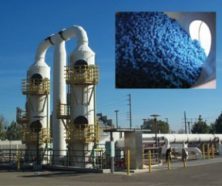Eating up foul sewage smells
Bacteria can break down the chemical responsible for sewage's rotten-egg smell.
Share this:
- Share via email (Opens in new window) Email
- Click to share on Facebook (Opens in new window) Facebook
- Click to share on X (Opens in new window) X
- Click to share on Pinterest (Opens in new window) Pinterest
- Click to share on Reddit (Opens in new window) Reddit
- Share to Google Classroom (Opens in new window) Google Classroom
- Click to print (Opens in new window) Print
By Emily Sohn
Stinky sewage is a big problem—and not just for your nose.
The smell of rotten eggs that wafts out of wastewater drains and treatment plants is an unwelcome visitor anywhere. In order to meet required standards of air quality, sewage-treatment plants use toxic and expensive chemicals to fight the stench.
 |
|
Unlike the left tower, which uses chemicals, the tower on the right at this wastewater-treatment plant now uses bacteria-covered foam blocks (inset) to eliminate the hydrogen sulfide bubbling from treated sewage.
|
| Deshusses/PNAS |
Now, researchers say they’ve found a better, cheaper, more natural way to subdue foul sewage smells. The secret? Bacteria and water.
The horrible rotten-egg smell of sewage is caused by a gas called hydrogen sulfide. To get rid of it, most treatment plants use devices called chemical scrubbers, which filter the gas through a cocktail of dangerous chemicals. Chemical scrubbers work, but they are expensive and often dangerous.
Two researchers tried something different. In a sewage treatment plant in California, they replaced chemical scrubbers with bacteria that break down hydrogen sulfide.
The scientists loaded a container with little foam blocks full of the bacteria. Then, they pumped hydrogen gas through the chamber. Finally, they let water constantly trickle over the foam. The system worked so well that the California plant converted several chemical scrubbers to the new kind.
If the technique catches on, sewage rot might become equally kind to the earth and to your nose.—E. Sohn
Going Deeper:
Travis, John. 2003. A breath of fresh air: Bacteria rid sewage of its stink. Science News 163(May 10):294. Available at http://www.sciencenews.org/20030510/fob7.asp .







